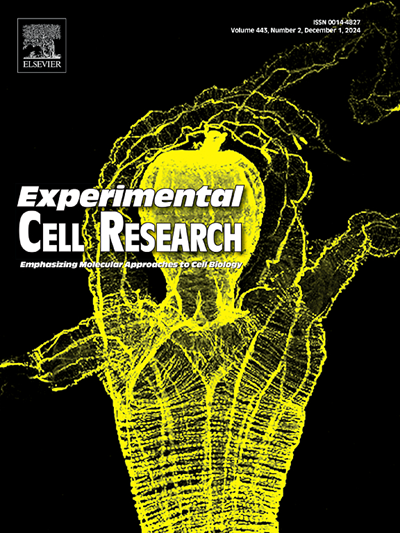Evaluation of the impact of miR-3143 on the PI3K/AKT signaling pathway and its subsequent influence on the metastatic phenotype of triple-negative breast cancer cells
IF 3.3
3区 生物学
Q3 CELL BIOLOGY
引用次数: 0
Abstract
MicroRNAs (miRNAs) are recognized to have a pivotal role in the progression and metastatic dissemination encompassing diverse cancer varieties, such as triple-negative breast cancer (TNBC). Recent evidence has suggested that specific miRNA species can directly or indirectly influence the onset, progression, and relapse of TNBC. Previous studies have reported the frequent reduction of miR-3143 in TNBC, which appears to coincide with the activation of proliferative signaling pathways. However, the potential restorative effects of miR-3143 on TNBC cellular behavior remain unexplored. In the present study, we utilized exosome-mediated delivery to introduce miR-3143 into TNBC cells and investigated its impact on the PI3K/AKT pathway and the resulting effects on cellular proliferation, movement, and apoptosis. MDA-MB-231 TNBC cells underwent treatment with miR-3143-electroporated human umbilical cord mesenchymal stem cell (HUCMSC)-derived exosomes. RT-qPCR analysis was utilized to assess the influence of miR-3143 overexpression on the expression of its target genes, PIK3CA and AKT1, which was further validated through dual-luciferase reporter assays. Our results demonstrated that the overexpression of miR-3143 could effectively decline the level of AKT1 and PIK3CA by directly binding to their 3′-UTRs. Furthermore, the introduction of miR-3143 into TNBC cells resulted in a significant enhancement of apoptotic activities. Interestingly, the delivery of miR-3143 via HUCMSC-derived exosomes could inhibit the protumorigenic and prometastatic behaviors of TNBC cells, potentially limiting their malignant progression. Collectively, these findings enhance comprehension of the regulatory mechanisms by which miR-3143 can modulate the metastatic potential of TNBC cells. The insights gained from this study may facilitate the creation of innovative miRNA-targeting approaches to combat the aggressive nature of TNBC andstrengthen treatment effectiveness.
评估 miR-3143 对 PI3K/AKT 信号通路的影响及其对三阴性乳腺癌细胞转移表型的后续影响
MicroRNAs (miRNAs)被认为在包括三阴性乳腺癌(TNBC)在内的多种癌症的进展和转移传播中起着关键作用。最近的证据表明,特定的miRNA种类可以直接或间接地影响TNBC的发病、进展和复发。先前的研究报道了TNBC中miR-3143的频繁降低,这似乎与增殖信号通路的激活相一致。然而,miR-3143对TNBC细胞行为的潜在恢复作用仍未被探索。在本研究中,我们利用外泌体介导的递送将miR-3143引入TNBC细胞,并研究其对PI3K/AKT通路的影响以及由此产生的对细胞增殖、运动和凋亡的影响。用mir -3143电穿孔人脐带间充质干细胞(HUCMSC)来源的外泌体处理MDA-MB-231 TNBC细胞。采用RT-qPCR分析评估miR-3143过表达对其靶基因PIK3CA和AKT1表达的影响,并通过双荧光素酶报告基因实验进一步验证。我们的研究结果表明,过表达miR-3143可以通过直接结合AKT1和PIK3CA的3 ' - utr有效降低它们的水平。此外,将miR-3143引入TNBC细胞可显著增强细胞凋亡活性。有趣的是,通过hucmsc衍生的外泌体递送miR-3143可以抑制TNBC细胞的致瘤性和前转移性行为,可能限制其恶性进展。总的来说,这些发现增强了对miR-3143调节TNBC细胞转移潜能的调控机制的理解。从这项研究中获得的见解可能有助于创造创新的mirna靶向方法来对抗TNBC的侵袭性并加强治疗效果。
本文章由计算机程序翻译,如有差异,请以英文原文为准。
求助全文
约1分钟内获得全文
求助全文
来源期刊

Experimental cell research
医学-细胞生物学
CiteScore
7.20
自引率
0.00%
发文量
295
审稿时长
30 days
期刊介绍:
Our scope includes but is not limited to areas such as: Chromosome biology; Chromatin and epigenetics; DNA repair; Gene regulation; Nuclear import-export; RNA processing; Non-coding RNAs; Organelle biology; The cytoskeleton; Intracellular trafficking; Cell-cell and cell-matrix interactions; Cell motility and migration; Cell proliferation; Cellular differentiation; Signal transduction; Programmed cell death.
 求助内容:
求助内容: 应助结果提醒方式:
应助结果提醒方式:


